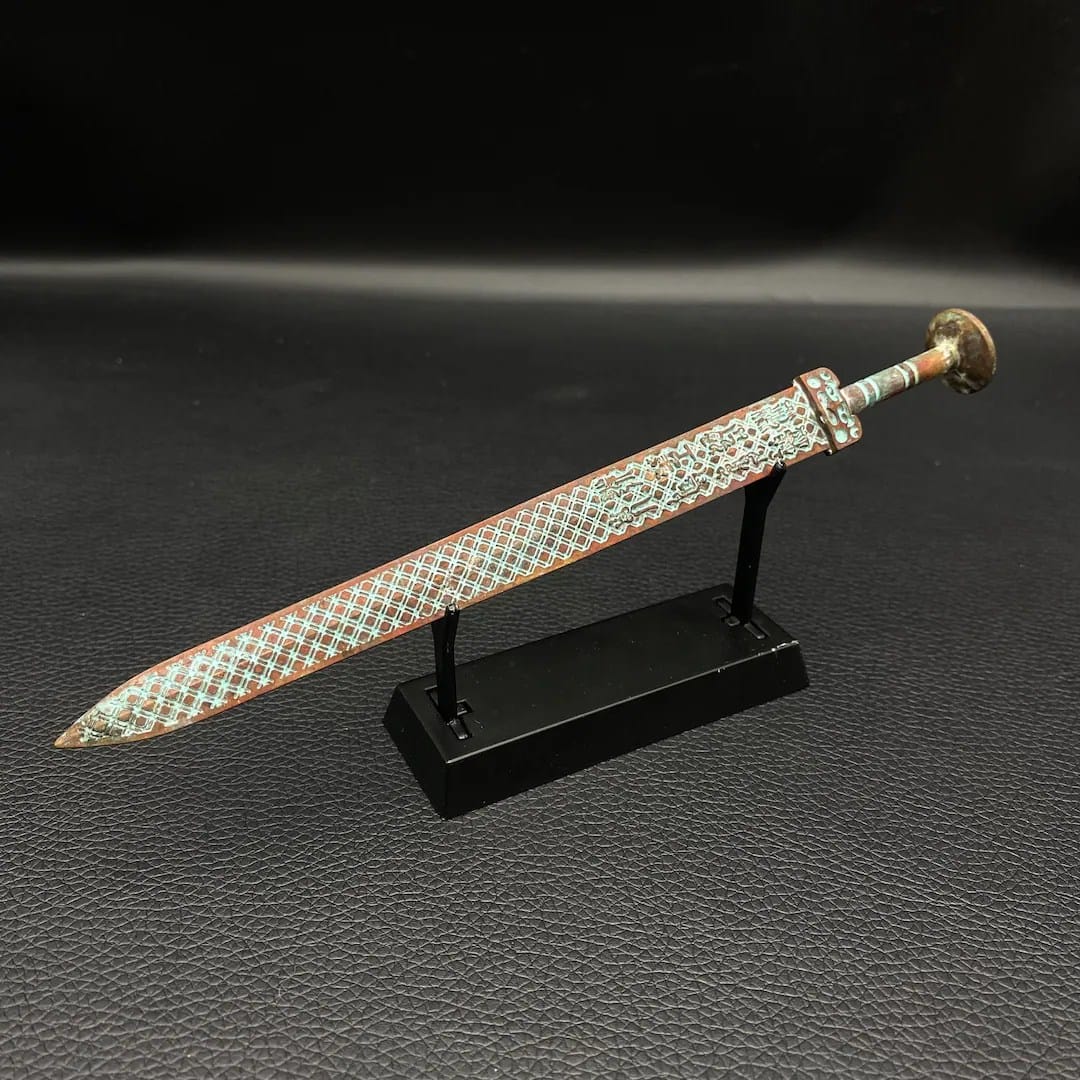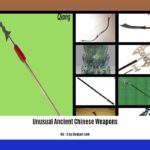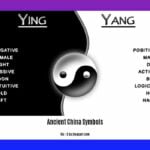A Sword Sharper Than Time
Imagine a sword, pulled from the earth after 2,500 years, still sharp enough to draw blood. That’s the Goujian Sword. This isn’t just any ancient relic – it’s a symbol of how incredibly skilled the ancient Chinese were at metallurgy, even all those centuries ago.
Discovered in 1965 by archaeologists exploring tombs revealed during the Zhang River Reservoir project, the Goujian Sword lay undisturbed, sealed within its tomb. Amazingly, the sword inside was as pristine as the day it was made. It was like opening a time capsule!
What they found stunned everyone. The sword, a little over 55 centimeters long, was in unbelievable condition. It was made from tin bronze, an alloy we know the ancient Chinese used, but the way it was crafted was mind-blowing. The blade was still incredibly sharp – and we mean really sharp. But the real mystery was its resistance to rust and tarnish. How could a sword this old look brand new?
The sword’s inscription, written in an ancient script, held the answer to at least one mystery – who it belonged to: “Goujian,” the king of Yue. This wasn’t just any sword; it was the King Goujian’s personal weapon!
Even today, scientists are struggling to fully understand how the ancient Chinese created something so advanced. The type of bronze, the sharpness of the blade, and especially that mysterious corrosion resistance – it all suggests a level of skill we don’t usually associate with that time period. Some believe a thin layer of chromium oxide might be the secret to its preservation, but we still don’t know for sure.
The Goujian Sword is more than just a weapon, though. It’s a symbol of China’s creative spirit and technological prowess, even in the distant past. Today, you can find it displayed in museums, featured in documentaries, and discussed in countless books. It serves as a bridge between us and ancient China, sparking wonder and imagination in everyone who encounters it.
The Goujian Sword is a testament to the enduring power of human ingenuity. It serves as a reminder that even in the face of time, incredible creations can endure, inspiring us to push the boundaries of what’s possible.
Is the Sword of Goujian Real?
Emerging from a tomb sealed tight for centuries, the legendary Sword of Goujian, unearthed in 1965, stunned the world. After more than 2,500 years, the sword was still incredibly sharp. This discovery immediately begs the question, is this for real? Could this sword really be a genuine relic from ancient China, or is it a carefully crafted fake?
Experts who have examined the sword agree: it’s the real deal. This isn’t just some lucky guess, either. The sword’s remarkably pristine condition, combined with an inscription that clearly identifies it as belonging to King Goujian himself, leaves little room for doubt. It’s a genuine piece of history.
The real mystery isn’t about the sword’s authenticity – it’s how this ancient weapon managed to resist the relentless march of time. How could it possibly remain in such incredible condition after all these years?
The answer likely lies in the way the sword was made. Crafted from a special blend of tin bronze, the sword possesses an inherent resistance to corrosion, a quality that would prove essential to its preservation. As if this inherent resilience wasn’t enough, the sword had one more preservation factor on its side: the tomb’s airtight seal. This oxygen-free environment, known as an anaerobic environment, further inhibited any degradation, effectively halting the natural process of decay.
The sword’s impressive sharpness isn’t just a consequence of its remarkable preservation. It speaks volumes about the incredible skill possessed by ancient Chinese metalsmiths. The blade’s edge, forged from high-carbon steel, boasts a level of hardness that rivals the precision of modern surgical scalpels. Imagine that – technology from over two millennia ago, capable of achieving the sharpness we associate with modern medical instruments!
The Sword of Goujian is much more than just an old artifact; it represents the pinnacle of ingenuity and craftsmanship in ancient China. This single object challenges our understanding of what past civilizations were capable of, urging us to reconsider our assumptions about history. More importantly, it stands as a testament to human creativity and its ability to endure throughout the ages, serving as a source of inspiration for generations to come.
The Goujian Sword: More Than Just “Good”
“Good” might be a bit of an understatement when describing the Goujian Sword. Unearthed in 1965, the 2,500-year-old weapon, pulled from an ancient tomb, was practically untouched by the passage of time. We’re talking pristine condition after two and a half millennia! It’s like finding a brand-new car buried since the days of the Roman Empire. The Goujian Sword isn’t just “good,” it’s a mind-blowing testament to the sheer skill and artistry of ancient Chinese craftspeople.
What makes this sword so special? It’s not just its age, though that’s certainly a big part of it. The fact that the blade, made from a special mix of tin and bronze, is still razor-sharp after all these centuries is mind-boggling. Experts believe this speaks volumes about the advanced metalworking skills they possessed back then. But the sword isn’t just a feat of engineering; it’s a work of art. The intricate patterns etched into its surface, along with the turquoise inlays, demonstrate an incredible level of artistic talent and detail work.
The Goujian Sword shatters our preconceived notions about what ancient technology was capable of. It forces us to re-evaluate our understanding of the past. It’s a time capsule that throws open the door to a world we thought we’d lost to time. And it raises many questions: How did they create something so durable? What techniques did they use? These are questions that researchers are still trying to unravel today, and every new discovery adds another layer to the mystery and wonder of the Goujian Sword.
The Mystery of the Oldest Sword
Imagine a sword, buried for over 2,000 years, pulled from the earth practically good as new. That’s the story of the Goujian Sword, a relic from ancient China that’s challenging our understanding of just how skilled ancient craftspeople really were.
Found in 1965, this isn’t just any old sword. It actually has an inscription on it that reads, “King of Yue Goujian, self-made this sword for his personal use.” Talk about a personalized weapon! The sword dates back to the Spring and Autumn period in China (771 to 476 BC), a time of incredible innovation and change.
Now, you might be wondering how a sword that old could possibly survive in such good condition. It’s a question that has puzzled experts for years! The Goujian Sword is made from an alloy of copper and tin, with tiny amounts of lead, sulfur, and iron mixed in. This special blend likely plays a role in its preservation, but it’s still a mystery why it hasn’t rusted away after all this time.
The fact that the Goujian Sword is still razor-sharp after centuries is a testament to the incredible skill of its makers. It wasn’t just built to last; it was built to perform. Even today, this ancient weapon can slice through stacks of paper like it’s nothing!
So, while we may never know all the secrets of the Goujian Sword, one thing is clear: it stands as a powerful symbol of ancient Chinese ingenuity and a reminder that some things really do stand the test of time.
Key Points About the Goujian Sword
- Age: 2,500 years old
- Discovery: Found in 1965 in a sealed tomb near the Zhang River Reservoir project.
- Condition: Pristine, as if newly made
- Materials: Tin bronze alloy
- Length: 55 centimeters
- Sharpness: Incredibly sharp
- Corrosion resistance: Exceptional, still looks brand new
- Inscription: Identifies it as belonging to King Goujian of Yue
- Significance:
- Symbol of ancient Chinese craftsmanship
- Evidence of advanced technological prowess
- Inspires wonder and imagination
- Represents the enduring power of human ingenuity
Throughout the ancient world, the worship of various gods and goddesses played a significant role in the lives of people. God Milcom, for instance, was a prominent deity in ancient Carthage. In the New Testament, the location known as Golgotha holds immense historical and religious significance, serving as the site of the crucifixion of Jesus Christ.
- Unlocking Francis Alexander Shields’ Finance Empire: A Comprehensive Biography - July 12, 2025
- Unveiling Francis Alexander Shields: A Business Legacy - July 12, 2025
- Francis Alexander Shields’ Business Career: A Comprehensive Overview - July 12, 2025
















1 thought on “The Goujian Sword: A 2,500-Year-Old Testament to Ancient Chinese Craftsmanship”
Comments are closed.